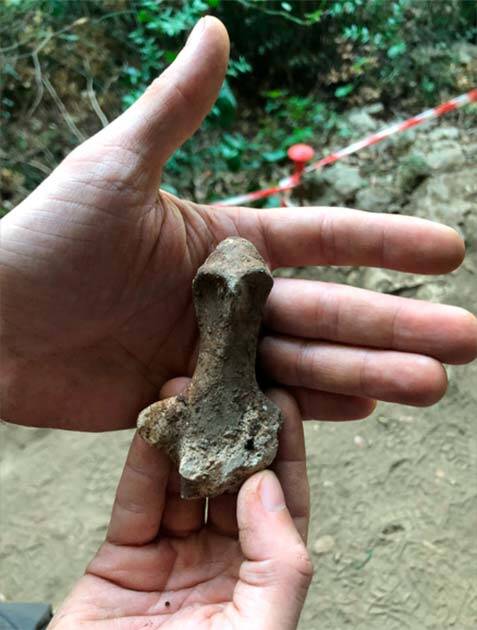The figurine dates to the Neolithic period, when ancient people first started to develop farming communities in Italy.

Sapienza University of RomeThe female figurine may have represented a woman, a deity, or merely been a doll.
Battifratta Cave in Poggio Nativo, Lazio, Italy, has long intrigued archaeologists. Situated by a seasonal spring, the cave drew ancient people with its promise of shelter and water. Now, archaeologists believe the cave may have also played a ritualistic role, thanks to a mysterious female figurine discovered during recent excavations there.
The clay figure is around 7,000 years old and dates from the Neolithic period. But Italian researchers aren’t entirely sure what the object represents.
“A woman, a deity, a doll?” a statement from Sapienza University of Rome pondered. “Who does the clay figurine… represent?”
Whatever it represents, the researchers agree that the figure is “very rare” for Italy and “almost absent in the Tyrrhenian regions.” Though the figure itself is quite simple, researchers note in the Sapienza University of Rome statement that its facial features are “outlined schematically” and that its creator seemed to take more care with “the hairstyle and body decorations.”
But though its purpose appears ambiguous for now, the figure does seem to reveal something about Battifratta Cave.

Sapienza University of RomeResearchers standing at the mouth of Battifratta Cave, where the 7,000-year-old clay female figurine was discovered.
As the Sapienza University of Rome statement explains, excavations at Battifratta Cave unearthed a number of other objects, as well as a human skeleton. This has led researchers to suspect that the cave, with its seasonal spring, may have played a spiritual role as well as a practical one.
“The presence of pottery, lithic industry, faunal and botanical artefacts on several stratified levels reveals the use of the spring and the cave not only for water supply but also for burial and ritual purposes, as evidenced by the human skeletal remains found and the clay figurine,” Cecilia Conati, a Classics professor at Sapienza University, explained in the statement.
Though there’s still much for researchers to learn about these “burial and ritual purposes” at Battifratta Cave, other ancient sites in Italy offer hints.
As Ancient Origins notes, ancient sites at Valcamonica (Camonica Valley) and Arene Candide in Liguria, each dating to around 7,000 B.C.E., appear to include ritualistic and ceremonial elements like petroglyphs. Therefore, it’s not a stretch to believe that Battifratta Cave was used for a similar purpose.
Nor is it a stretch to believe that the figurine found at Battifratta Cave may have served some ritualistic purpose. Female figures like the one found in the cave have been discovered before. The most famous example is perhaps the Venus of Willendorf statue, which is 30,000 years old and depicts a voluptuous woman made out of limestone.

Bjørn Christian Tørrissen/Wikimedia CommonsThe Venus Of Willendorf is one of the most famous ancient female figurines ever discovered and predates the one found in Battifratta Cave by tens of thousands of years.
Researchers suspect that the Venus of Willendorf statue — and others like it — likely served ritualistic purposes and celebrated fertility, femininity, and eroticism. It’s possible that the female figurine in Battifratta Cave played a similar role for ancient people in the region.
Though its true purpose is unknown, researchers are eager to learn more about the cave and its role in ancient societies. As the statement from the Sapienza University of Rome noted, the female figurine is one piece in a much larger puzzle. They declared:
“This valuable find will add much new information about what is turning out to be a key site in the prehistory of Lazio and central Italy.”
After reading about the “very rare” 7,000-year-old Neolithic figurine discovered in an Italian cave, see how the largest known cave art in North America was discovered in an Alabama cave. Or, go inside the discovery of 150 skulls in a Mexican cave from people who were ritualistically sacrificed in 900 C.E.





